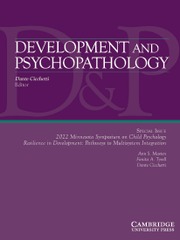No CrossRef data available.
Article contents
Parental emotion socialization and internalizing problems in childhood and adolescence: A meta-analytic review
Published online by Cambridge University Press: 11 September 2025
Abstract
Anxiety and depression symptoms and disorders are the leading child mental health problems in western societies. This systematic review evaluated how parental emotion socialization (ES) relates to children’s internalizing problems (from birth to age 18 years). Three meta-analyses, evaluating supportive (k = 50, N = 10,698), nonsupportive ES behaviors (k = 47, N = 10,970), and elaboration (k = 6, N = 867) were conducted. Supportive ES behaviors had a very small negative association with children’s internalizing problems (r = −.06), nonsupportive ES behaviors had a medium positive association with internalizing problems (r = .18), and elaboration had a small negative association with internalizing problems (r = −.11). Very few significant moderators emerged, and no differences based on parent gender were found. The results suggest that incorporating an ES framework in intervention and preventive efforts might be beneficial for children at risk of experiencing internalizing problems.
Keywords
Information
- Type
- Regular Article
- Information
- Copyright
- © The Author(s), 2025. Published by Cambridge University Press


